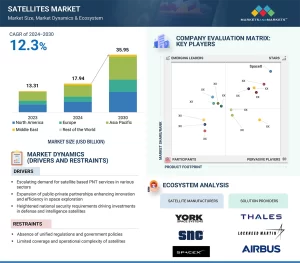The Satellite Platforms Market is witnessing significant expansion due to advancements in technology, increased satellite launches, and growing applications in communication, defense, and Earth observation. As global demand for connectivity and data analytics rises, satellite platforms play a crucial role in shaping the future of space-based services.
Market Overview and Growth Projections
The global satellites market was valued at USD 17.94 billion in 2024 and is projected to reach USD 35.95 billion by 2030, growing at a CAGR of 12.3%. The number of satellites launched worldwide stood at 3,154 units in 2024, and this number is expected to increase to 5,048 units by 2030, growing at a CAGR of 8.2%.
The rapid expansion of the Satellite Platforms Market is driven by the increasing need for global connectivity, space-based broadband, and advanced communication networks. The rise of Low Earth Orbit (LEO) satellite constellations is enhancing 5G networks, IoT applications, and smart city solutions, making satellite technology indispensable for various industries.
Download PDF Brochure: https://www.marketsandmarkets.com/pdfdownloadNew.asp?id=189500332
Key Drivers of the Satellite Platforms Market
1. Growing Demand for Satellite-Based Communication
The global push for seamless connectivity has led to an increased demand for satellites providing broadband internet and secure communication services. Countries and companies are investing in large-scale satellite constellations to bridge the digital divide and offer reliable internet services in remote regions.
2. Expansion of Defense and Security Applications
Satellites play a vital role in defense applications such as intelligence gathering, reconnaissance, and secure military communication. Governments worldwide are investing in space-based defense systems to enhance national security, surveillance, and real-time monitoring capabilities.
3. Advancements in Earth Observation and Data Analytics
The rising demand for data-driven decision-making has propelled the need for satellites equipped with advanced imaging and analytical capabilities. Industries such as agriculture, climate monitoring, and disaster management benefit from high-resolution satellite imagery and real-time data analytics powered by AI and machine learning.
4. Innovation in Satellite Propulsion and Launch Technologies
The development of green propulsion systems and reusable launch vehicles has significantly reduced the cost of satellite launches. Companies like SpaceX, Lockheed Martin, and Airbus are actively investing in next-generation satellite platforms to improve efficiency and sustainability.
5. Asia Pacific’s Expanding Space Industry
Countries like China, India, Japan, and South Korea are making substantial investments in satellite technology and space exploration programs. Asia Pacific is expected to dominate the Satellite Platforms Market, driven by government-backed initiatives, commercial partnerships, and advancements in 5G and smart city infrastructure.
Challenges in the Satellite Platforms Market
1. Limited Coverage and Operational Complexity
Although satellite constellations enhance global coverage, individual satellites have limited operational capacity. Deploying large-scale satellite networks requires significant investment in ground infrastructure, satellite maintenance, and collision avoidance technologies.
2. Rising Concerns Over Space Debris
The increasing number of satellites in orbit has led to the accumulation of space debris, posing risks to active satellites and future space missions. According to NASA and ESA, more than 150 million objects orbit Earth, including 27,000 large objects that could potentially collide with operational satellites.
3. High Costs and Technological Barriers
Despite advancements in satellite manufacturing, the cost of developing and launching satellites remains high. Small and emerging space companies often struggle with funding constraints, regulatory approvals, and technological limitations, slowing down market entry.
Opportunities in the Satellite Platforms Market
1. Increasing Demand for Data Analytics
The demand for real-time satellite data is driving the growth of data analytics solutions across industries. Companies like ICEYE are leveraging radar satellite imagery to provide actionable insights for sectors such as insurance, defense, and logistics.
2. Public-Private Partnerships and Investments
Governments and private companies are forming strategic partnerships to accelerate satellite deployments. Public-private collaborations are enabling the development of next-generation communication satellites, Earth observation platforms, and space exploration missions.
3. Emerging Markets and Commercialization of Space
The commercialization of space is opening new opportunities for startups and established companies. Innovations in satellite miniaturization, cloud-based satellite operations, and on-demand satellite services are expanding the market scope beyond traditional applications.
Segment Analysis of the Satellite Platforms Market
By Satellite Mass: Dominance of Large Satellites
Large satellites are expected to dominate the market, reaching USD 17.06 billion by 2030 at a CAGR of 7.6%. These satellites are crucial for high-capacity communication, defense operations, and weather monitoring.
By Application: Communication Satellites Leading the Market
The communication segment is projected to be the leading application in the Satellite Platforms Market. The need for broadband internet, 5G networks, and IoT integration is driving the adoption of high-performance communication satellites.
Key Players in the Satellite Platforms Market
The Satellite Platforms Market is highly competitive, with major players investing in innovation, strategic partnerships, and new satellite constellations. Key players include:
- SpaceX (US)
- Lockheed Martin Corporation (US)
- Airbus Defence and Space (Germany)
- Northrop Grumman (US)
- Thales Alenia Space (France)
- L3Harris Technologies, Inc. (US)
- Mitsubishi Electric Corporation (Japan)
- Maxar Technologies (US)
- York Space Systems (US)
- Boeing (US)
Ask for Sample Report: https://www.marketsandmarkets.com/requestsampleNew.asp?id=189500332
Future Outlook of the Satellite Platforms Market
The Satellite Platforms Market is poised for exponential growth with continuous advancements in satellite technology, artificial intelligence, and space exploration. Key trends shaping the future include:
- The integration of AI and ML for real-time satellite data processing and analytics.
- The expansion of private space missions and commercial satellite deployments.
- The development of mega-constellations for global broadband coverage.
- The implementation of sustainable space technologies to tackle space debris management.
The Satellite Platforms Market is at the forefront of technological innovation, transforming industries through communication, data analytics, and Earth observation. As global demand for satellite-based services continues to rise, market players must focus on cost-effective solutions, advanced propulsion technologies, and sustainable space practices to ensure long-term success. With ongoing investments in AI, IoT, and 5G, the future of satellite platforms promises enhanced connectivity, smarter analytics, and expanded commercial opportunities in the years ahead.
